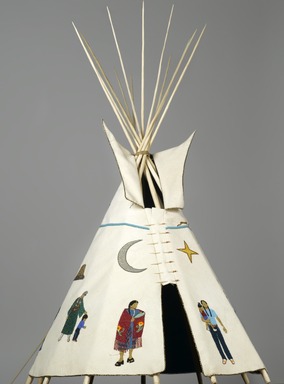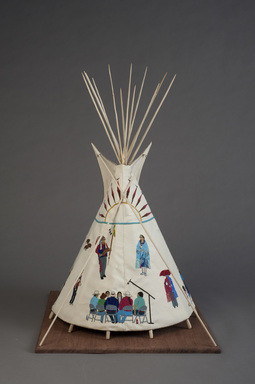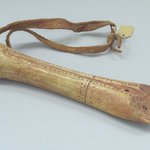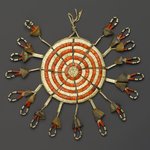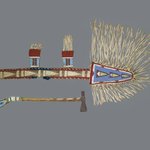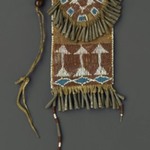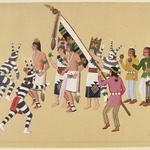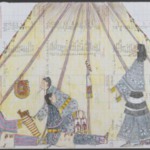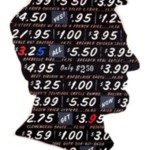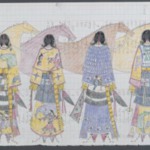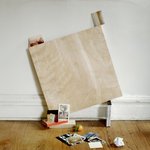21st Century Traditional: Beaded Tipi
Arts of the Americas
My tipi is about a Kiowa way of life, passed down through the generations. The tipi represents the home and the heart of family, community, and tribal nation. In staking down a tipi, a way of life is staked down and thus sacred space is created and held. This is what the Water Protectors are doing by staking their tipis down—they are creating and holding sacred space in a place that once again is under threat by the United States government. For Plains people, both northerners like the Standing Rock and southerners like the Kiowa, the tipi is the center of life and its presence declares that Natives hold that place.
—Teri Greeves, 2019
The artist Teri Greeves celebrates Kiowa culture with this model tipi featuring beaded images of modern-day family and community life as well as of the ancestral beings who created the Kiowa people and brought the stories, ceremonies, and values that continue to be passed down from generation to generation.
The tipi is also the center of life and identity for another Plains tribe, the Standing Rock Sioux of South and North Dakota (see photograph). The tribe’s water source is threatened by the Dakota Access Pipeline (DAPL), which has been transporting crude oil from shale fields in northwestern North Dakota to a terminal in Illinois since June 2017. Originally slated to cross the Missouri River near Bismarck, North Dakota, the pipeline was moved just upstream of the Standing Rock Reservation to avoid the possibility of contaminating the state capital’s drinking water. Despite numerous lawsuits and protests, many of which culminated in violence toward the protesters, the pipeline was completed after President Donald Trump issued an executive order in January 2017. The pipeline currently handles 570,000 barrels a day, but the companies that own it (Energy Transfer and Sunoco) have applied to double its capacity to 1.1 million barrels a day. The Standing Rock Sioux are still engaged in court battles to challenge the pipeline permits.
MEDIUM
Brain tanned deer hide, charlotte cut glass beads, seed beads, bugle beads, glass beads, sterling silver beads, pearls, shell, raw diamonds, hand stamped sterling silver, hand stamped copper, cotton cloth, nylon "sinew" rope, pine, poplar, bubinga
DATES
2010
DIMENSIONS
includes base: 46 x 29 x 32 1/2 in. (116.8 x 73.7 x 82.6 cm)
(show scale)
ACCESSION NUMBER
2008.28
CREDIT LINE
Florence B. and Carl L. Selden Fund
CATALOGUE DESCRIPTION
This model tipi is described in the artist's own words:
Those old decorated tipis came to people in visions. Each one had its own story, born out of that person's space and time. My tipi is a 21st Century vision.
Our elders living today didn't fight in the Indian wars, they fought in Viet Nam. Our Indian kids living today don't play much with rawhide gaming wheels, they play with X-boxes. When men and women sing around the drum, more than likely their drum stick is made out of PVC pipe and a wireless microphone transmits their voices through loudspeakers.
Grandmothers and grandfathers have managed to give us mothers and fathers non-tangibles that are at the heart of what it is to be Indian, and in my case, Kiowa. It is our job to pass those intangibles down to our children. The tools we use to pass those along...for me, those are just tools.
I have aligned the images on this tipi starting at the doorway, which faces east. A mother and father stand around the door proudly holding their small children; purposefully I have dressed all of the figures in a mixture of traditional and 21st Century clothing. Moving left, (around the tipi cover) the women occupy the southern side of the tipi: a grandmother in traditional clothing watching a child, a mother in Black Leggings dance clothing walking with her daughter in shorts and a t-shirt, an elderly woman in a Gourd Dance shawl holding an umbrella and wearing iconic high heels. On the western side, the drum occupies the space, men in [sic] obviously in today's world using today's technology to sing songs that are literally timeless. Continuing to move left, the men occupy the northern side of the tipi. A Gourd Dancer with a rockabilly haircut, a Viet Nam vet shaking the hand of a new Army recruit, an Oklahoma Grandpa with a little boy.
Above the figures is the sky/myth world: the morning star and the new moon around the eastern doorway, the setting sun at the western side. Spiderwoman and her husband, Stony Road rest above; those great Kiowa beings that survived the flood, before Saynday brought us into this world. On the southern side, the Bear Rock or Devil's Tower stands with the 7 Kiowa Star Girls above (Pleiades). This was a story I grew up hearing many times. Having heard the story two ways with both Pleiades and the Big Dipper being named as the Star Girls, I have included the Big Dipper on the opposite side (as it stands in the night sky). And crazy old Saynday leaves his hand print in the constellation, Orion. A group of buffalo runs across the top of the northern side, their medicine being called upon for many things, a soldier's needs especially.
This tipi is my vision then of a 21st Century Traditional-of that passing of intangibles through one generation into the next through dance, ceremony, myth, history, family and community values. These things have helped to make me into the Kiowa that I am. I pray for guidance to pass these most precious things onto my children.
MUSEUM LOCATION
This item is not on view
CAPTION
Teri Greeves (Kiowa, born 1970). 21st Century Traditional: Beaded Tipi, 2010. Brain tanned deer hide, charlotte cut glass beads, seed beads, bugle beads, glass beads, sterling silver beads, pearls, shell, raw diamonds, hand stamped sterling silver, hand stamped copper, cotton cloth, nylon "sinew" rope, pine, poplar, bubinga, includes base: 46 x 29 x 32 1/2 in. (116.8 x 73.7 x 82.6 cm). Brooklyn Museum, Florence B. and Carl L. Selden Fund, 2008.28. © artist or artist's estate (Photo: Brooklyn Museum, 2008.28_PS2.jpg)
IMAGE
overall, 2008.28_PS2.jpg. Brooklyn Museum photograph, 2010
"CUR" at the beginning of an image file name means that the image was created by a curatorial staff member. These study images may be digital point-and-shoot photographs, when we don\'t yet have high-quality studio photography, or they may be scans of older negatives, slides, or photographic prints, providing historical documentation of the object.
RIGHTS STATEMENT
© Teri Greeves
The Brooklyn Museum holds a non-exclusive license to reproduce images of this work of art from the rights holder named here.
The Museum does not warrant that the use of this work will not infringe on the rights of third parties. It is your responsibility to determine and satisfy copyright or other use restrictions before copying, transmitting, or making other use of protected items beyond that allowed by "fair use," as such term is understood under the United States Copyright Act.
For further information about copyright, we recommend resources at the
United States Library of Congress,
Cornell University,
Copyright and Cultural Institutions: Guidelines for U.S. Libraries, Archives, and Museums, and
Copyright Watch.
For more information about the Museum's rights project, including how rights types are assigned, please see our
blog posts on copyright.
If you have any information regarding this work and rights to it, please contact
copyright@brooklynmuseum.org.
If you wish to contact the rights holder for this work, please email
copyright@brooklynmuseum.org and we will assist if we can.
RECORD COMPLETENESS
Not every record you will find here is complete. More information is available for some works than for others, and some entries have been updated more recently. Records are frequently reviewed and revised, and
we welcome any additional information you might have.
